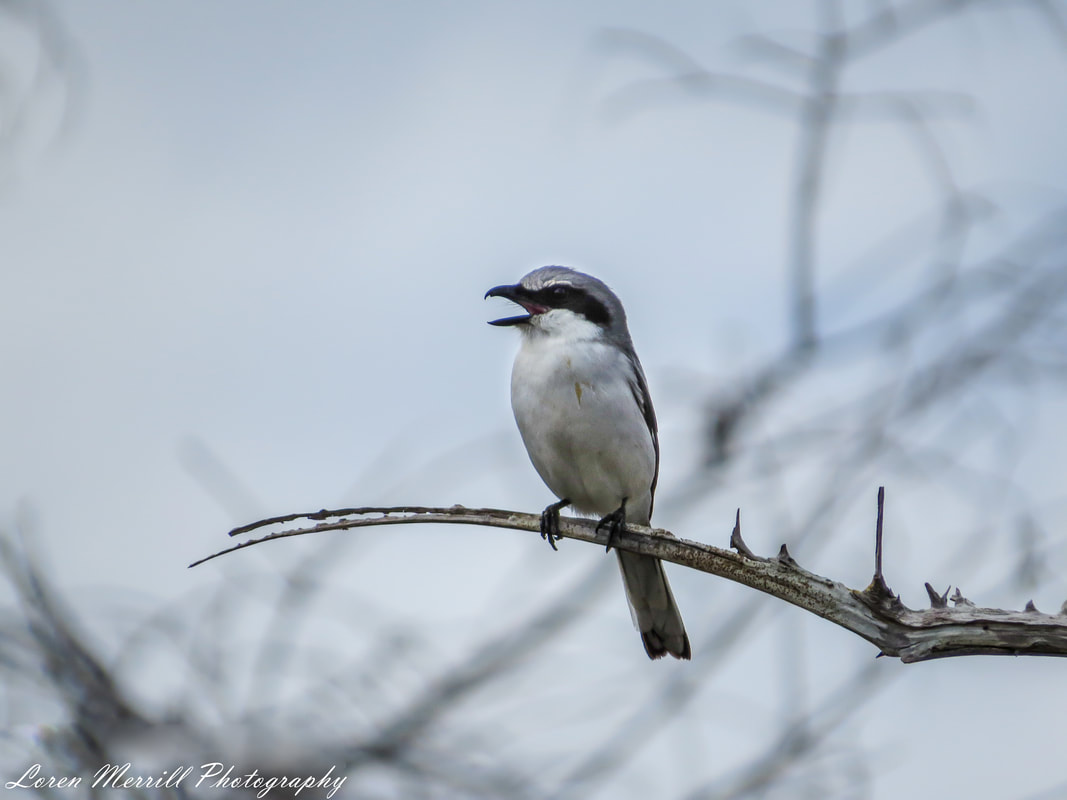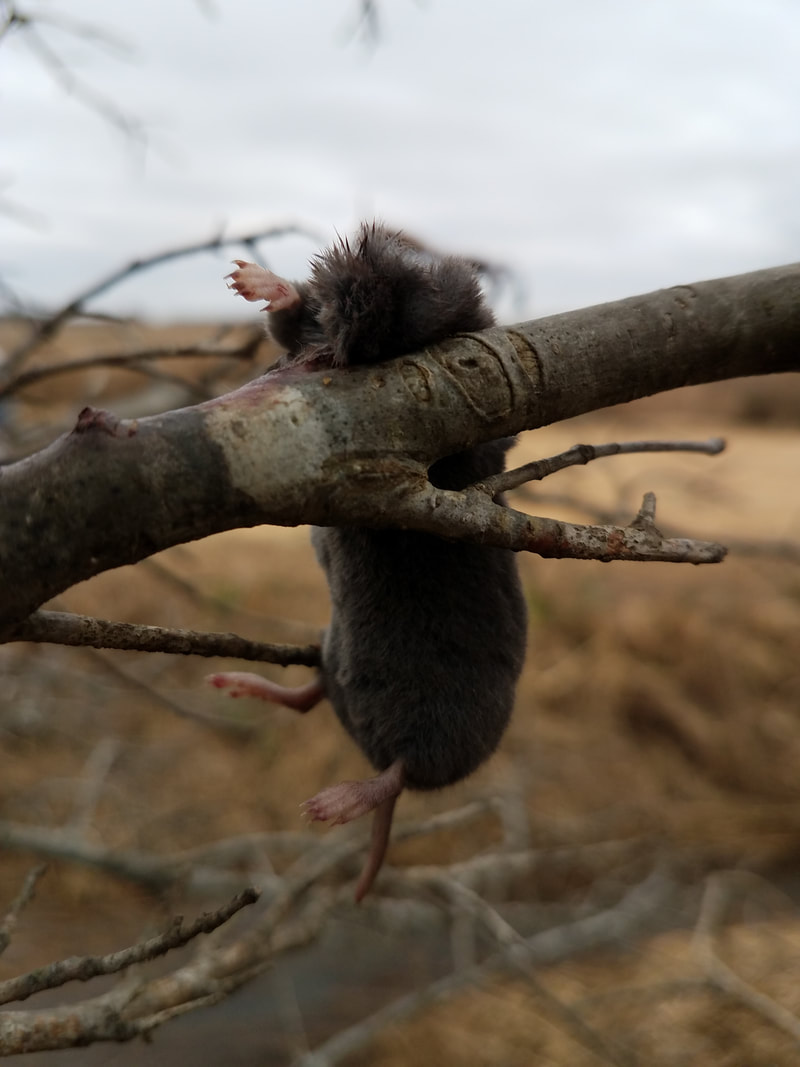|
I peered out through the curtain of falling snowflakes, breath condensing on the fabric of my facemask, and eyelashes sticking to one another in the single-digit temperatures. I plodded through the calf-deep snow, making my way up a narrow trail bordered by young aspen trunks and a mixture of Engelman and blue spruce, ponderosa and limber pines. I had already been out for almost two hours and aside from a few dark-eyed juncos, a flock of red crossbills, and four suspicious mule deer, the other animals appeared to have made the wise choice of hunkering down. With a high of 7 degrees Fahrenheit that day, and the mercury dropping, I was second-guessing my decision to venture out in such conditions. It was so cold I had taken the battery out of my camera and had it inside my glove along with an activated Hothands packet. I tried not to think about the cold, but instead focused on keeping my eyes and ears alert for any signs of life in the white world around me. The reasons I had forsaken the comfort of our toasty house were twofold: one, there were unlikely to be any other people out and about in such conditions, which improved my chances of spotting human-shy wildlife; and two, there was a chance the storm could bring in some interesting bird rarity. As the trail approached a dirt road, the vegetation opened up into a small meadow with a few willow and alder thickets clustered around the edges. I glanced up and saw a plump bird with a long tail atop a tall pine, swaying in the wind. My first thought was northern pygmy owl, which I had been hoping to see for weeks. I quickly realized it was not an owl at all, but another predatory bird—a northern shrike. Shrikes have an unusual ecology; they are songbirds like thrushes, sparrows, and warblers, but unlike most other songbirds, the 33 species in the shrike family are carnivorous. Shrikes eat a lot of insects, but they also eat vertebrates such as small mammals, birds, reptiles, and amphibians. Shrikes have a wicked hooked beak that they use to immobilize and kill their prey, and then use to tear off bite-sized pieces. These are not your run-of-the-mill backyard songbirds—just imagine watching a robin stalking mice instead of worms, and then piercing the mouse’s neck with its beak. You’d never look at robins the same way again. But shrike ecology gets even more fascinating. These fearsome predators are not armed with the same suite of tools as their contemporaries, the hawks, eagles, falcons, and owls; shrikes lack talons. Instead of talons, they have normal songbird perching feet which are not well-equipped for predatory duties. One way in which shrikes have gotten around this oversight by natural selection is to use their environment, and they have done so with gruesome efficiency. Shrikes often skewer their prey on sharp objects such as thorns, broken branches, and barbed wire. This stabilizes the prey allowing the bird to tear into the food with its beak. It is this behavior that has earned shrikes the name “butcherbirds” (their family name Laniidae is derived from the Latin word for butcher). Shrikes also store food in this fashion, and a few years ago I got to experience a shrike cache in person. I was visiting friends in Arkansas who work with another North American shrike species, the loggerhead shrike, and one afternoon we went to the territory of a nesting pair of these birds. Loggerhead and northern shrikes superficially resemble northern mockingbirds-they are about the same size and shape, and the bold gray and white plumage is relatively similar. Shrikes and mockingbirds also like to perch on exposed branches or power lines, but the shrike’s resemblance to the fruit and insect-eating mockingbirds ends there. All around the shrike nesting area there were little bodies impaled on thorns and barbed wire; frogs, snakes, lizards, grasshoppers, partial remains of small mammals, all serving as a grisly warning to any small animal in the area to watch the skies. This caching behavior allows the shrikes to store food for times when prey is less plentiful, and provides a nice back-up when the nestlings turn into adolescents and begin demanding lots of food. Back in the high elevation deep freeze of Colorado, I watched the northern shrike surveying its surroundings from the top of the pine. Suddenly it dropped through the falling snow and landed in one of the alder thickets up the trail from me. I lost sight of the bird for a few minutes, and when I had drawn even with the shrike, I could see that it was eating something. I snapped a few photos which revealed that the shrike had caught a small songbird, likely a junco or chickadee, and was hastily gulping it down, feet and all. I was impressed; this was a first-year bird (apparent from its duller mask and browner plumage), and clearly it had already mastered the art of catching avian prey. Northern shrikes eat mostly birds and small mammals in the winter months, and have been known to capture and kill prey substantially larger than themselves, including rock pigeons, mourning doves, American robins, blue jays, and lemmings. They use both sit-and-wait and active pursuit strategies for hunting and are capable of chasing down other birds in flight. It is also possible that a bit of deception is included in their repertoire. They don’t really resemble traditional avian predators like falcons and hawks, and other birds may not be alert to the danger they represent, especially if they’ve never encountered a shrike before. This was certainly not the case a few weeks past when I came across a Clarke’s nutcracker harassing another young northern shrike. The nutcracker had chased the shrike into a tall aspen and was scolding the young predator from a nearby branch, and occasionally pecking at it with its long beak. The shrike was clearly agitated, and was yelling back at the nutcracker, snapping its bill in agitation. The young shrike finally shed its agitator and flew off to pursue hunting in a more private location. The nutcracker, for its part, winged over to some nearby limber pines, likely feeling a bit of self-satisfaction at having driven off the butcher of the north. At least for the moment. Our other focal bird this week is the dipper, and like the shrikes, it is a songbird with an unusual ecology; the American dipper is North America’s only aquatic songbird. These rotund birds (also known as “ouzels”) spend their entire lives in and around water, mostly fast-flowing streams and rivers of high-elevation habitats. They are occasionally found along the edges of ponds, lakes, and marine environments, but the quintessential dipper territory is a boulder-strewn stream tumbling down the side of a forested mountain. Here these slate-gray birds can be found bobbing their bodies (hence the name “dipper”) while standing on rocks protruding from the water, or wading through the swift-flowing current, grasping the slick substrate with long, strong claws. And then, suddenly, the bird will be gone, vanished beneath the boiling surface, to reappear nearby a few moments later with a small aquatic invertebrate in its beak. A little over a week ago, I was following the South Platte River through Waterton Canyon, south of Denver, and I came across an actively bobbing American dipper. Dippers forage almost exclusively underwater and employ a variety of techniques to secure their food. The individual I found was especially accommodating and allowed me to watch it from close quarters, where I could observe many of its foraging tactics. The simplest maneuver is when it would stick just its head underwater and look around for aquatic inverts attached to nearby substrate. It also frequently plunged into the water and swam to the bottom, where it would then walk around, turning over rocks, leaves and sticks for hidden prey. This sounds straightforward, but it was able to perform this act in the very fast-flowing current by using its strong feet to hold onto the bottom. In addition to walking on the stream floor, it would occasionally swim around underwater, searching the perimeter of submerged rocks, peering into crevices and poking into cracks for attached inverts. Dippers can also pursue mobile prey underwater, chasing after minnows with powerful wing-propelled thrusts. Like other aquatic birds, dippers have a transparent third eyelid called a nictitating membrane that allows them to see clearly underwater. They also come equipped with an exceptionally warm, feather-lined wetsuit that keeps them dry and warm, even in freezing temperatures, although they have to spend a substantial portion of their day preening to keep their feather-suit functioning properly. Dippers also have low metabolic rates and higher oxygen carrying capacity of their blood relative to similarly sized songbirds, both of which are thought to be adaptations to their cold, aquatic lifestyles. Those who have seen an American dipper will probably agree that, aside from its tendency to dive under water, the most conspicuous aspect of its behavior is the constant bobbing. The function of the dipper’s dipping isn’t clear but could serve as a form of visual communication to other dippers in the area, or could help mask the dipper’s presence from predators. American dippers also have bold white, feathered eyelids, which really become apparent when the bird blinks. Like the dipping behavior, the purpose of this bold marking is unclear, but it likely serves as some signal to other dippers. On the vocal communication front, dippers produce a loud, musical song, consisting of sweet bell-like tones and harsher staccato notes. John Muir described it this way: "[H]is music is that of the streams refined and spiritualized. The deep booming notes of the falls are in it, the trills of the rapids, the gurgling of margin eddies, the low whispering of level reaches, and the sweet tinkle of separate drops oozing from the ends of mosses and falling into tranquil ponds." —John Muir, 1894. Dippers sing year-round, but they ramp up the singing activity prior to and during the breeding period in late winter/early spring. Once dippers have found a mate, they begin building their nests. Dippers build a large, ball-like nest constructed of moss on the outside, and leaves and grass on the inside. They often place their nest behind a waterfall or under a hanging structure along the side of the stream or river. Once the young hatch, the parents work full-time to keep those hungry mouths fed. These duties continue even after the chicks leave the nest, as the parents continue to provision the fledglings until they are ready to take the plunge and embrace a world no other North American songbird knows; the world under the water’s surface.
Next post: TBD Subscribe to the Newsletter: If you would like to get notifications about when new posts are up and other tidbits related to the blog, sign up for the View Out the Door weekly newsletter. Just email viewoutthedoor “at” gmail “dot” com with the subject header SUBSCRIBE.
0 Comments
Leave a Reply. |
About the author:Loren grew up in the wilds of Boston, Massachusetts, and honed his natural history skills in the urban backyard. He attended Cornell University for his undergraduate degree in Natural Resources, and received his PhD in Ecology from the University of California, Santa Barbara. He has traveled extensively, and in the past few years has developed an affliction for wildlife photography. Archives:
|














